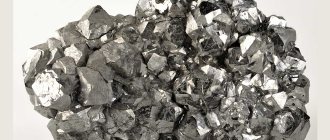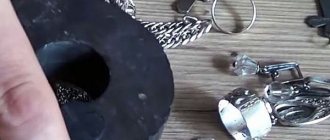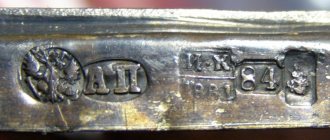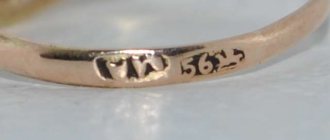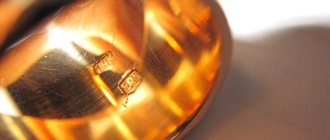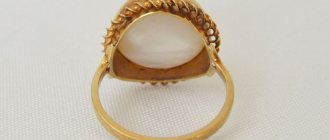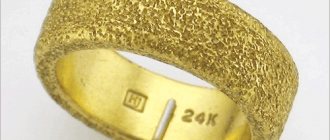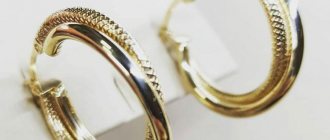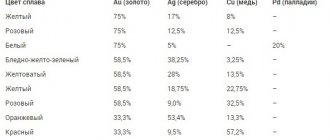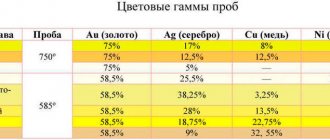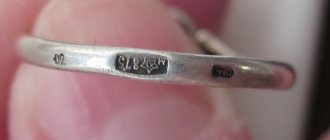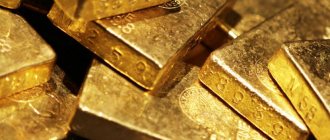September 16, 2021
Fans of precious metals, at least once in their lives, were seriously interested in what kind of silver is used in earrings, rings, chains, bracelets and other jewelry. Like gold, it uses alloys that increase strength and protect against damage. But it’s not just 925-carat metal that has a recognizable matte sheen – today there are several classifications that determine the high cost and unique appearance of a product.
Now you will find out what type of silver has proven itself best in precious production, how the composition of specific alloys differs, and how to determine their quality.
What is a sample
Silver in its pure form, like gold, is unsuitable for making jewelry: it is too soft and unstable to mechanical stress. To improve the properties necessary for decorative and applied applications, a master alloy is added to the melt - other metals that have the desired qualities.
The precious metal in the alloy is valuable - when remelted, impurities will be removed. Therefore, the cost of the product is calculated not from the total mass, but from the mass of silver (rare exceptions are antiques and works of art). The sample is needed to mark the percentage of pure silver in the product.
What impurities are added to silver?
The main component of a silver alloy is copper. There are combinations with nickel - with a nickel content of up to 1%, the mechanical properties of the alloy are improved. Lead, antimony, iron and bismuth are present in microscopic quantities in jewelry alloys. Cadmium and zinc can be introduced - such compounds are used to make silver solders.
Application of this alloy
Jewelry for undemanding customers is made from the material described. 875 is stronger than 925, so it is harder to process. Rings, chains, bracelets, rings - this is the assortment of the 875th sample. Gemstone inlays are not uncommon for this material as it can hold them.
Also, the 875th sample is used to make tableware and candlesticks. No matter what year it is, silver tableware always remains a prestigious feature. Back in the late 19th and early 20th centuries, many houses and restaurants were furnished with silver sets.
But with the increasing costs of their production, as well as the need for constant cleaning, they were supplanted by their more practical counterparts. Cigarette cases, ashtrays, cup holders, and shot glasses are now common.
What types of silver are there?
The metric testing system has won primacy in the world, but I will also talk about the ancient ones.
Spool system
In 1747, the Russian pound, consisting of 96 spools, became the standard measure of weight in the Russian Empire. This was inconvenient: the pound existed in different countries and meant different measures everywhere. In addition, there was also an apothecary pound, which weighed less. However, it was the trade pound that was taken as the basis for the spool system.
100% of the mass of the alloy consists of 96 spools, that is, 1 spool is equal to 1/96 of the mass of the product. To convert the spool test to metric, you need to divide the indicator by 96 and multiply by 1000.
Lot system
The lot system is similar to the spool system, only 16 lots, which make up 1 mark, are accepted as 100%. The system was abolished in 1888; now mentions of it can only be found in literature. Converting the value to the metric system is done by multiplying the lot standard by 1000 and dividing by 16.
Carat system
Carats are used mainly in the West: Canada, USA, Switzerland. Mentions of them can be heard on TV and read in the media. 100% refers to the number 24. Measuring the purity of silver this way is a mistake: karat is only used to mark gold.
Metric system
It is familiar to all of us since childhood and consists of 1000 ‰ (ppm, 1/10 percent) of the total mass of the alloy. 999 sample is pure metal (1000 does not exist, because absolute purity is impossible in the physical world), 785 sample contains 75.8% (758 ‰) silver. We use the decimal number system, so the metric standard is clearer and more convenient for us.
System correspondence table
Let's look at the table that you can use if you encounter an unusual designation. Not all samples are used in jewelry. Some are distributed abroad, but are not produced here. I exclude the karat system because it was not applied to silver.
| Metric testing | 999 | 960* | 925* | 875* | 830 | 800 | 750 | 500 |
| Lot testing | 16 | 15,4 | 14,8 | 14 | 13,3 | 12,8 | 12 | 8 |
| Spool testing | 96 | 92 | 88,8 | 84 | 80 | 76,8 | 72 | 48 |
(*) - used for making jewelry in modern Russia.
Which sample is the best?
When asked which is better, it is worth asking a counter-question: better for what? The highest standard you can find in a store is 960: it contains a small amount of copper. 925 is considered optimal - it is less susceptible to deformation, so it is more comfortable to wear.
If we are not talking about rings and earrings, but about silver solder, then a good combination would be an 860 alloy with zinc: it does not tarnish in the air and is effectively polished - however, it is inferior in strength to solders without zinc.
Expert opinion
Vsevolod Kozlovsky
6 years in jewelry making. Knows everything about samples and can identify a fake in 12 seconds
High purity is not always beneficial. Jewelers make locks for chains and bracelets from metal with a breakdown lower than the bracelet itself (720 or 750). Locks tend to break when used intensively - this technique extends the life of the decoration by introducing a strong ligature into the alloy.
What samples were used in the old days
Sample 875 was widely used in pre-revolutionary Russia (it is still used today). In spool equivalent, it was designated by the number 84, and in Germany, before the introduction of the metric system, such a product would have been stamped “14”.
In the Russian Empire, 900 standard ("banking") was used - for bars and coins - and a coin alloy of 500 ("royal coinage").
What types of silver are there in Russia?
In jewelry stores you can find two:
- 925 - for high quality jewelry (standard);
- 875 - for simpler and cheaper products.
925 sterling jewelry is whiter and shines brighter. The color of less high-grade metal is duller.
Alloys of 800 samples (800, 830) are used for the manufacture of souvenirs and cutlery.
Where can you buy or sell
You can buy 875-grade silver in numerous jewelry stores and pawn shops. Their addresses can be found on the Internet. Read reviews before purchasing. You can sell them in the same organizations.
How much does 1 gram of silver of this standard cost today?
The price changes every day and is set by the Central Bank of Russia. You can find it on the bank's website. Moreover, the price of the 999th sample is indicated. It needs to be multiplied by 0.875, and the cost of a gram will be 875 marks. For convenience, I suggest using a “live” graph and table.
| Price 999 standard according to the Central Bank | Market value of the sample today | Scrap price | Price in jewelry |
Types of silver
When we read an article or a book, before the word “silver” we come across adjectives that are not always clear. Let's see what they are and what they mean.
Rhodinated
Rhodium plated silver is not an alloy. Rhodium plating is a technique of galvanic (electrolytic) coating of a product with a thin (up to 0.25 microns) layer of rhodium, a rare and very durable metal.
Rhodium-plated jewelry has a number of advantages:
- shine - brighter than that of plain silver;
- wear resistance;
- ability to resist deformation.
Most often, high-grade items are coated with rhodium: they are both more expensive and less resistant to mechanical stress.
Sterling
Sterling silver is very familiar to us. This is a 925 alloy that can be bought at any store and from which most of our jewelry is made. The name “sterling” is rooted in the history of Britain - it was from this type of silver that standard sterling coins were made in the 12th century by order of King Henry II.
There are several hypotheses about the origin of the word, based on the names of ancient coins in Germany, England and Normandy.
Blackened
Blackened silver, like rhodium plated silver, is a type of coated metal. Thanks to blackening, the fashion for which appeared in Russia in the 17th century (the birthplace of the technique was Veliky Ustyug), it became possible to produce household items with miniature patterns. Nowadays such silver is used to make jewelry and souvenirs look antique.
There are three technologies for blackening (coating with an oxide film that simulates oxidation): chemical, galvanic and mechanical. Blackening is also available at home (patination with iodine and sulfur ointment).
Filigree
Filigree, also known as filigree, is a pattern of thin wire and grains on the surface of a product. It can be background (the metal sheet remains part of the item) or openwork (the original sheet is removed, leaving airy silver lace). Filigree can be seen in any museum where there is an exhibition depicting the life of the nobility - on silver spoons, glass holders, and cutlery stands.
This is a very elegant technique, characteristic of Tsarist Russia and appreciated abroad while having a typically Russian flavor.
Matte
Matted products are obtained by creating microscopic roughness on the surface of the product. This is done in hardware - using a machine resembling a sandblaster. Such things cannot be polished, stones are rarely inserted into them - it is believed that the glossy shine of silver goes better with gems.
Matte silver looks impressive in combination with “classic” shiny silver - in a double ring or chain with alternating links. The matting technique is used to create geometric patterns or decorations in a botanical style.
Leaf
Silver leaf, similar to gold leaf, is used for continuous coating of objects. Forged into thin sheets, it decorates the interiors of temples and palaces. This is a metal of the highest standard. Domes are not covered with it - it is less resistant to external influences than gold and requires additional coating.
In the old days, the finishing layer was egg white, now it’s waterproof varnish.
Colloidal
Colloidal silver is a metal dispersion (suspension of nano- and microparticles). It is used in cosmetology and alternative medicine. Dispersed silver has no proven effectiveness, the results of experiments with it are controversial, most often it is sold as a dietary supplement (dietary supplement).
Dining room
In Russia until 1927, when the metric system was introduced, and in the USSR, the standard of silverware was most often 875 (according to the spool system - 84). Now it is also used - along with 925, which was popular in Europe until the 20th century.
Any coverage listed above is available. You can go to a jeweler and have your favorite spoon treated with rhodium to make it shine brighter and last longer.
Technical
The phrase “technical silver” has two meanings.
Technical can be understood as a metal used in electronics (contacts), electrics (wires), photographic equipment (film, x-rays). This is high-grade silver - inert, non-refractory, flexible, with good thermal and electrical conductivity.
It could be radio engineering scrap.
What standard is silver in jewelry?
Jewelers in Russia use:
- in most cases - 925;
- in the mass market segment - 875;
- for elite sets - 960.
How to check the sample on jewelry
There is no regulation as to where exactly the mark is located. The location of the imprint is chosen by the jeweler based on the shape of the jewelry: it should be invisible when worn, but not hidden in a hard-to-reach place. Products consisting of alloys of different purities have two marks - on each of the parts (an example is a high-grade bracelet with a low-grade, that is, more durable, lock).
Marking and hallmarking of silver jewelry
Branding is regulated by the state. In addition to the sample, the item is stamped with the nameplate of the manufacturer (the license is renewed every year, so the code on the nameplate must be current).
The abbreviation denoting a silver alloy looks like a combination of the letters СрМ with the sample value: СрМ 925, СрМ 720.
Which sample is better for jewelry
925 is considered optimal - it combines the shine and corrosion resistance of low-ligature silver with greater strength compared to the elite 960 standard.
What standard is used on silver bars and coins?
Ingots are produced from “bank metal” and always have the highest possible fineness - close to 1000. According to GOST 28595-90, the total mass of impurities cannot exceed 0.01 g.
Markings on silver spoons
Silver markings vary from manufacturer to manufacturer, but an hallmark is required. However, confusion may arise: for example, in the old days, the hallmark was set not only on silver, but also on silver-plated products.
And there are simply too many alloys similar to silver to count! If products made from them were produced in the Soviet Union or Russia, they will also be stamped (of course, without the coveted numbers):
- AL – aluminum;
- MELCH – cupronickel, an alloy of copper and nickel;
- MNC – nickel silver, copper and nickel plus zinc;
- MN – monel, cupronickel with a high nickel content;
- STAINLESS – “stainless steel”, that is, stainless steel.
Naturally, such cutlery is not silver and does not represent much value.
How to protect yourself from counterfeiting
It happens that the 925 mark is on a low-quality product. There are funny cases: a person buys 825-grade jewelry, and when he goes online at home, he discovers that 825-grade does not exist at all. Fraudsters take advantage of buyers' ignorance.
How to determine the authenticity of silver at home
There are several ways.
- Boil the product. If it is silver, it will quickly heat up so that it will be difficult to hold in your hand.
- Run over it with a lapis pencil: the silver will not darken.
- Scratch the item from the inside with a needle: the silver will not change color, but the silver plating will be erased, revealing a dark area.
- Rub the jewelry with chalk and rub vigorously between your palms. If the chalk powder has darkened, the silver is real.
Reviews
For several years, the whole family has been using silver cutlery from the Sokolov brand, which corresponds to 800 standard. We only take out the set for holidays and try to take care of it. The appliances look as attractive as the day they were purchased.
Masha L., Kastroma
Lydia I. g, Ivanovo
Silver spoons for the child were brought as a gift from Italy. On the handles of the spoons I saw the number 800 and a five-pointed star. It turned out that the picture means the country of origin, and the number means the sample of silver. I really liked the gift.
I discovered someone’s forgotten set of silver salt shakers in a recently purchased house. The items apparently date back to the times of the USSR, I realized this from the 800 mark next to the worker’s head. The set is clearly of historical value; I kept it as a souvenir.
Vitaly N., Yaroslavl
Recommendations for care, cleaning and storage
The technology for caring for and cleaning silver is the same as for gold: we wear it carefully, take it off before running a hundred meters, do not store it mixed with other jewelry, rinse it with soapy water, polish it with a cloth, do not use abrasives.
Special attention is required to blackened silver and to products with stones. An acidic environment, ammonia and soda are contraindicated for them. If the jewelry is set not with stones, but with amber, corals or pearls, then it is better to refuse to clean it yourself and take the item to a workshop.
History of the Assay System
Hallmarks, which were placed on silver items from the eighteenth to the early twentieth centuries, indicated their value. From them it was possible to determine when and where the product was made and even which craftsman worked on it. The assay system in Russia was created by Tsar Peter I. By special decree, four samples of silver and gold were determined; the assay system was called spool.
At that time, only the master and the elder had the right to brand products. Selling anything made of precious metal without a hallmark was prohibited. Those who had the right to make impressions were even trained specifically for this.
Already in the nineteenth century, special chambers were equipped for hallmarking silver and other metals. The print itself has also undergone changes. It began to contain the coat of arms of the city where the item was made, the sign of the inspector (initials) and the sample of the metal. At that time, a new assay charter was also adopted, according to which the empire was divided into assay districts, and the mark took the form of a woman’s head in a kokoshnik. The stamp also contained the initials of the head of the district and a hallmark. Since they began to brand a product indicating the place where it was made, it has become possible to recognize the works of great masters.
Mark on a silver fork
